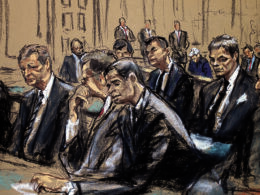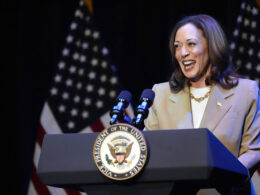CNN
—
A week into Ukraine’s surprise cross-border incursion into Russia, it’s becoming increasingly clear that Moscow does not have the situation under control.
Tens of thousands of Russians have been forced to flee their homes as Ukrainian troops continued to encroach onto Russian territory over the weekend and on Monday.
The incursion – the first time foreign troops entered Russian territory since World War II – is a major embarrassment for the Kremlin. Russian President Vladimir Putin vowed to “kick the enemy out” or Russia, but his troops are yet to stop the Ukrainian advance.
Here’s what we know.
What happened?
The first reports of Ukrainian troops crossing into Russia’s Kursk region, just north of the Ukrainian border, started to emerge late last Tuesday. But it wasn’t until several days later that Kyiv officially acknowledged its military was operating inside Russia.
The incursion marked a notable change of tactics from Kyiv. The Ukrainian military has in the past regularly attacked targets inside Russia with drones and missiles, and there have been limited cross-border attacks by Ukraine-aligned Russian saboteurs, but until last week it had not launched any official ground incursions across the border.
By Monday, Kyiv claimed to have control over some 1,000 square kilometers (386 square miles) of Russian territory. In terms of its size, it’s similar to the amount of Ukrainian land Russia managed to seize so far this year, estimated by the US-based Institute for the Study of War (ISW) at 1,175 square kilometers (453 square miles).
Still, the area is dwarfed by the more than 100,000 square kilometers, or 18% of Ukraine’s total territory, taken by Russia since the conflict started in 2014.
Why is Kyiv doing this?
The objective of the incursion remains a mystery.
Kyiv is likely trying to achieve several goals: reclaim the initiative and boost the morale of its soldiers while diverting Russia’s attention and embarrassing Putin.
Ukrainian President Volodymyr Zelensky said over the weekend that the incursion was a way to put “pressure on the aggressor.”
On Monday, he added that it was “only fair” and beneficial to destroy the Russian positions that are used to launch strikes against Ukraine, saying thousands have been launched from the Kursk region since the beginning of June.
“Russia must be forced into peace if Putin wants to continue waging war so badly,” he said.
The Ukrainian government said it didn’t intend to annex Russia’s territory in the same way Moscow has annexed Crimea and other areas seized from Ukraine.
“Unlike Russia, Ukraine does not need (foreign territories). Ukraine is not interested in taking the territory of the Kursk region. But we want to protect our people’s lives,” spokesperson for the foreign ministry Heorhii Tykhyi said on Tuesday.
Ukraine has been under increased pressure along the 600-mile front line as Moscow in recent months, even as the long-awaited US military aid started to arrive to the front.
Moscow’s slow, grinding offensive along the entire frontline has been forcing Ukraine to commit to defensive operations rather than gear up for a counteroffensive.
While Russia’s advances have been mostly incremental, it has recently managed to inch towards several strategically important towns and roads in eastern Ukraine.
How has Putin reacted?
With fury. The scale of the crisis became clear on Monday, when Putin held a tense meeting with top security and government officials and the heads of the border regions, vowing to “kick the enemy out.”
A video of the meeting published by the Kremlin shows Putin scolding his subordinates, at one point shutting down the Kursk region’s acting governor Alexei Smirnov as he attempts to outline the scale of the invasion.
Smirnov was telling Putin that the Ukrainians were some 11 kilometers deep into Russian territory when Putin cut him off saying he can get that information from the military and ordered him to focus on social and economic issues instead.
Putin is not used to having his authority and power challenged and the incursion is the second major humiliation for the president in just over a year, after the Wagner mutiny last June.
While the private mercenary group’s boss Yevgeny Prigozhin ultimately failed and ended up dead after trying to challenge Putin, the episode caused a major crack in the image the president has been cultivating for decades.
What does it mean for Russia?
The magnitude of the crisis cannot be underestimated. For more than a decade, since Russia sparked the conflict in eastern Ukraine and annexed Crimea in 2014, the war Moscow has been waging on Ukraine barely touched the Russian people.
Widespread sanctions imposed by the West on Russia made international travel difficult and foreign goods expensive or innacessible, but the sense of safety from foreign attack has remained more or less intact.
That changed once Ukraine began using drones and missiles to regularly strike deeper inside Russia earlier this year, especially after Kyiv got permission from some of its allies to use their weapons for cross-border strikes. The ground incursion makes it even more apparent.
Moscow has been scrambling to contain the attack. Russian authorities imposed a sweeping counter-terror operation in three border regions – Belgorod, Bryansk and Kursk – but stopped short of declaring the incursion an act of war.
The ISW said this was likely an attempt by the Kremlin to deliberately downplay the assault to prevent domestic panic or backlash over the fact that Russia was unable to defend its own borders.

What are Ukraine’s allies saying?
Putin has lashed out against Ukraine’s allies on Monday, claiming the “the West is fighting us with the hands of the Ukrainians.”
Yet everything seems to suggest that the incursion took by surprise not just Russia, but also some of Ukraine’s closest allies.
The Biden administration said last week it wasn’t made aware of Kyiv’s plans in advance, but it reiterated its support for Ukraine.
Speaking to reporters on Monday, the White House National Security Communications Advisor John Kirby said: “Make no mistake about it: This is Putin’s war against Russia. And if he doesn’t like it, if it’s making him a little uncomfortable, then there’s an easy solution: He can just get the hell out of Ukraine and call it a day.”
Similarly, the European Union, Germany, the UK and other Western countries expressed support for Ukraine.
What happens next?
Analysts are not expecting Ukraine to attempt to advance much further into Russian territory. The success of the incursion was largely down to the surprise factor, with Moscow scrambling resources to try to defend its borders.
Once Russian reinforcements are in place, it is unlikely Ukraine would be able to hold onto the territory it managed to seize.
Russia has already relocated some of its troops stationed in occupied southern Ukraine to the Kursk region, according to Ukrainian military officials.
Ukrainian Ground Forces Spokesperson Dmytro Lykhovii told Ukrainian media Tuesday that “some Russian military units” were moved to Kursk from the Pridniprovsky frontline and the Zaporizhzhia region in southern Ukraine. He caveated, however, that Russia had already amassed “a large number of personnel” in the Zaporizhzhia region.
“The number of units they are redeploying is relatively small to talk about any weakening or removal of the barrier to continue the offensive in the southern direction,” Lykhovii told Ukrainian TV outlet EspresoTV.
“We want to avoid the impression that we are already winning and that Kursk is ours. This is not the case at all. We emphasize that every segment and every area is important.”
Ukraine has spent the past few months trying to hold off further Russian advances, first while waiting for the long-delayed deliveries of US weapons and now as it awaits the newly recruited troops to get trained up and arrive to the front lines.
The incursion might have given it the boost it so desperately needed.
CNN’s Olga Voitovych and Sugam Pokharel contributed reporting.








